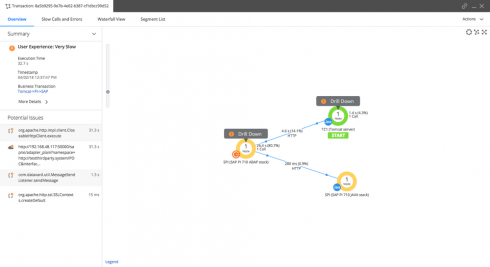
AppDynamics is offering a new tool that will let IT ops administrators determine code-level issues impacting SAP environments. The new AppDynamics for SAP will help trace code-level flaws responsible for degraded transaction and user experience performance, a capability until now restricted to the tools that come with the business application suite.
The new tool, an option for customers of the flagship AppDynamics APM offering, is an agent that can scan code built on SAP’s ABAP programing language and associated Business APIs (BAPIs). The agent can provide deep scanning of SAP’s various line of business software for ERP, CRM, HR and financial and its HANA streaming database platform and pinpoint code-level errors that could be the source of even the slightest performance issues, said Matt Chotin, a technical evangelist at AppDynamics.
“Every critical transaction that’s going from the customer application to the system of record, like SAP ERP or CRM, is mapped, and if any problems arise, you are able to see how those problems are occurring within AppDynamics, and reach resolution much faster,” Chotin said. While SAP provides this functionality in its own management tool, AppDynamics, now a division of Cisco, claims it’s the first APM provider to provide deep monitoring of the SAP application stack.
“They’re extending the visibility into what SAP does and the flow of transactions much further than anyone else is doing at the current moment,” said Gartner research director Charley Rich. “This is the next frontier that we believe APM vendors will focus on.”
Most APM tools from AppDynamics, New Relic, Dynatrace, Datadog and others are best suited at monitoring standard Java virtual machines and .NET-based C#, which make up the bulk of custom-developed enterprise applications rather than the native C++ code underlying SAP’s proprietary ABAP and other commercial application suites. While some APM providers may claim support for packaged apps, Rich noted that this is typically just for the Java-based portals. “You only get visibility into the Java transactions without any insight into how they’re related to any business functions,” Rich said.
Consequently, most organizations get the best APM monitoring information from those custom applications rather than packaged software. Only 5 percent of application software is currently managed by APM tools, a figure Gartner is estimating will rise to 20 percent by 2020, Rich noted. Rich said developing an agent that can perform deep code-level scanning into SAP’s ABAP code was not a trivial effort. “It’s hard to do and the challenge you have is getting certification from the vendors of those ERP applications,” Rich said.
AppDynamics’ Chotin said “we worked with SAP but it’s not a direct partnership.” Rich expaied the ability to get technical cooperation is important, but it would be even better if SAP was certifying and marketing it. Nevertheless, Rich said there’s a need to provide better performance monitoring of packaged enterprise applications. “I think it’s a white space that you’ll see over time you know many vendors going after because it’s obviously a revenue opportunity for them,” he said.
Indeed, AppDynamics believes there’s high demand, especially as organizations extend their implementations into cloud environments. “We’ve had a ton of customers asking for this,” Chotin said. The agents carry low overhead and can render code-level snapshots when there are any performance anomalies from their baseline. According to AppDynamics, the tool will pinpoint issues into a single line of ABAP code or from database queries.
AppDynamics provides real-time monitoring alerts in its own dashboard as well with integrations to ServiceNow, PagerDuty and JIRA. AppDynamics for SAP is available and licensed with on either a per application server basis. The cost for non-production, test/dev systems is 50 percent less.








